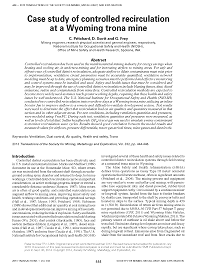Mining Publication: Case Study of Controlled Recirculation at a Wyoming Trona Mine
Original creation date: March 2014
Controlled recirculation has been used in the metal/nonmetal mining industry for energy savings when heating and cooling air, in undersea mining and for increasing airflow to mining areas. For safe and effective use of controlled district recirculation, adequate airflow to dilute contaminants must exist prior to implementation, ventilation circuit parameters must be accurately quantified, ventilation network modeling must be up to date, emergency planning scenarios must be performed and effective monitoring and control systems must be installed and used. Safety and health issues that must be considered and may be improved through the use of controlled district recirculation include blasting fumes, dust, diesel emissions, radon and contaminants from mine fires. Controlled recirculation methods are expected to become more widely used as mines reach greater working depths, requiring that these health and safety issues be well understood. The U.S. National Institute for Occupational Safety and Health (NIOSH) conducted two controlled recirculation tests over three days at a Wyoming trona mine, utilizing an inline booster fan to improve airflow to a remote and difficult-to-ventilate development section. Test results were used to determine the effect that recirculation had on air qualities and quantities measured in that section and in other adjacent areas. Pre-test conditions, including ventilation quantities and pressures, were modeled using VnetPC. During each test, ventilation quantities and pressures were measured, as well as levels of total dust. Sulfur hexafluoride (SF6) tracer gas was used to simulate a mine contaminant to monitor recirculation wave cycles. Results showed good correlation between the model results and measured values for airflows, pressure differentials, tracer gas arrival times, mine gasses and dust levels.
Authors: C Pritchard, D Scott, G Frey
Peer Reviewed Journal Article - March 2014
NIOSHTIC2 Number: 20045373
Trans Soc Min Metal Explor 2014 Mar; 334:444-448
See Also
- Above-the-Earth Field Contours for a Dipole Buried in a Homogeneous Half-Space
- Advances in Grid-Based Numerical Modeling Techniques for Improving Gas Management in Coal Mines
- Breaking the Ice on the Booster Fan Dilemma in US Underground Coal Mines
- Degasification System Selection for U.S. Longwall Mines Using an Expert Classification System
- Determination of In Situ Deformation Modulus for Cemented Rockfill
- Effects of Weak Bands on Pillar Stability in Stone Mines: Field Observations and Numerical Model Assessment
- Elastic and Shear Moduli of Coal Measure Rocks Derived from Basic Well Logs Using Fractal Statistics and Radial Basis Functions
- Investigation of induced recirculation during planned ventilation system maintenance
- Pillar Strength and Design Methodology for Stone Mines
- Stochastic Modeling of Gob Gas Venthole Production Performances in Active and Completed Longwall Panels of Coal Mines
- Content source: National Institute for Occupational Safety and Health, Mining Program


 ShareCompartir
ShareCompartir
